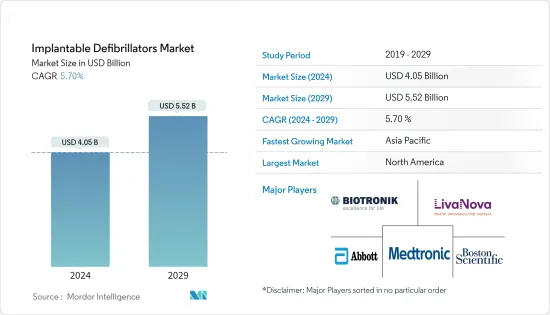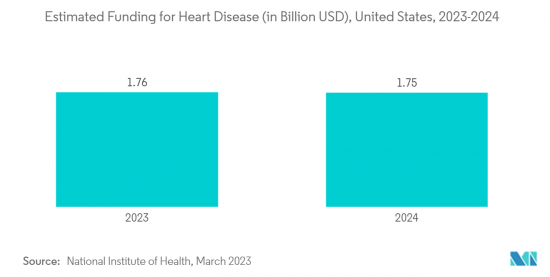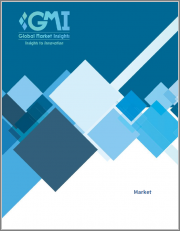
|
시장보고서
상품코드
1408319
이식형 제세동기 : 시장 점유율 분석, 산업 동향 및 통계, 성장 예측(2024-2029년)Implantable Defibrillators - Market Share Analysis, Industry Trends & Statistics, Growth Forecasts 2024 - 2029 |
||||||
이식형 제세동기(Implantable Defibrillators) 시장 규모는 2024년에 40억 5,000만 달러로 추정되고, 2029년에는 55억 2,000만 달러에 이를 것으로 예측되며, 예측 기간(2024-2029년)의 CAGR은 5.70%로 성장할 것으로 예상됩니다.

COVID-19는 COVID-19 환자의 심정지 증가로 인해 팬데믹기간 동안 이식형 제세동기 시장에 큰 영향을 미쳤습니다. 첫 번째 팬데믹시에는 시장이 감소했지만 COVID-19 환자에게 이식 가능한 제세동기 수요에 따라 증가했습니다. 예를 들어, 2022년 6월 Journal of Cardiac Failure에 게재된 연구에 따르면, 심부전 환자에 이식된 이식형 제세동기(ICD)는 심방세동(AF)과 같은 심장 상태 마커에 대한 유용한 정보를 제공했습니다. 이에 따라 COVID-19 팬데믹 시에 이식형 제세동기의 도입이 증가하여 팬데믹 후기 시장 성장을 가속할 것으로 예상되었습니다.
이식형 제세동기 시장의 성장을 가속하는 요인으로는 심실세동, 심실빈박 등의 부정맥, 심근경색이나 선천성 심질환 등 심장질환의 유병률 증가를 들 수 있습니다.
심부전과 같은 심장병의 유병률 증가는 시장 성장을 가속할 것으로 예상됩니다. 예를 들어 2022년 미국 심장협회 연례 보고서에 따르면 미국의 심부전 유병률은 2021년 약 600만 명으로 총 인구의 1.8%를 차지하고 있습니다. 또한 미국 질병 예방관리센터에 따르면 2023년 7월 2022년 미국에서 심근경색을 앓고 있는 18세 이상의 성인 비율은 총 인구의 3%였습니다. 이러한 심근경색의 대규모 유병률은 이식형 제세동기의 도입을 증가시키고 시장 성장을 가속할 것으로 예상됩니다.
또한 영국 심장재단에 따르면 2022년 8월 미국에서는 약 760만명이 심장·순환기 질환에 걸려 있습니다. 영국과 같은 선진국에서 심혈관 질환의 대규모 유병률은 이식형 제세동기에 대한 수요를 확대하여 조사 기간 동안 대상 시장의 성장을 가속합니다.
최근 기술 진보 증가와 이식형 제세동기의 성공률 향상은 시장 성장을 더욱 높일 것으로 예상됩니다. 예를 들어, 2022년 8월에 Medtronic PLC가 발표한 임상 연구는 갑작스런 심정지 중단을 목표로 하는 새로운 최소 침습 제세동기 임플란트(Medtronic EV ICD 시스템)의 효과를 입증했습니다. 이 혈관 외 이식형 제세동기 시스템은 왼쪽 겨드랑이에 있는 주요 구성요소를 포함하며 진동을 억제하고 빈맥을 예방하며 환자가 제세동 충격을 피하는 백업 페이싱 요법을 제공합니다.
따라서 심장 부정맥 및 기타 심장병의 유병률 증가는 심장 정지에 대한 조기 접근을 위한 이식형 제세동기 수요를 증가시킬 것으로 예상됩니다. 또한 예측 기간 동안 조사 대상 시장의 성장을 촉진 할 것으로 예상됩니다. 그러나 이식형 제세동기에 대한 엄격한 규제 프레임워크은 시장 성장을 방해할 것으로 예상됩니다.
이식형 제세동기 시장 동향
피하 이식형 제세동기(S-ICD)가 예측 기간 동안 가장 빠른 성장을 보일 것으로 예측됩니다.
피하 이식형 제세동기(S-ICD)는 심장 박동을 분석하기 위해 피하 전극을 사용하여 심실 빈맥/심실 세동을 효과적으로 감지, 식별 및 변환합니다. 심장 돌연사를 예방하기 위한 확립된 치료법으로, 특정 환자에게 경정맥 이식형 제세동기(ICD) 시스템을 대체합니다.
이 분야의 성장을 가속하는 요인으로는 주요 시장 진출기업의 대처가 활발해지고 있는 것과 사람들 사이에서 S-ICD에 대한 인식이 높아지고 있는 것을 들 수 있습니다.
주요 시장 진출 기업은 피하 이식형 제세동기의 안전성과 효능을 밝히기 위해 끊임없이 노력하고 있으며, 이는 이 분야의 성장을 가속할 것으로 예상됩니다. 예를 들어, 2021년 12월, Boston Scientific Corporation은 피하 이식형 제세동기의 효능, 성능 및 안전성을 평가하기 위해 S-ICD에 대한 연구를 수행했습니다. 그 결과, S-ICD 시스템은 심장이나 흉골 하부를 만지지 않고 보호할 수 있기 때문에 그 위치에 삽입된 리드와 관련된 많은 어려움을 방지할 수 있음을 시사하였습니다.
또한, 피하 이식형 제세동기는 다양한 장점을 가지고 있으며, 이 분야의 성장을 가속할 것으로 예상됩니다. 예를 들어 2021년 7월 Arrhythmia &Electrophysiology Review(AER) 잡지에 게재된 연구에 따르면 S-ICD는 기흉이나 심장 천공, 전신 감염 등 신규 이식에 의한 단기적·장기적인 위험을 많이 환자가 피하는 데 도움입니다. 또한, S-ICD는 다기관 공동 임상시험을 받았고, 그 효능이 입증되었고, 새로운 지견은 상황에 따라 경정맥 ICD보다 우수할 가능성이 있음을 보여주었습니다. 따라서 피하 이식형 제세동기와 관련된 이점은 수요를 증가시키고 조사 대상 부문의 성장을 견인하고 있습니다.
따라서, 피하 이식형 제세동기에는 큰 이점이 있기 때문에 이 부문은 예측 기간 동안 가장 빠르게 성장할 것으로 예상됩니다.

예측 기간 동안 북미가 조사 대상 시장의 주요 점유율을 차지할 전망
북미는 예측기간을 통해 이식형 제세동기 시장 전체에서 큰 점유율을 차지할 것으로 예상됩니다. 그 배경에는 높은 의료 지출, 부정맥, 조동, 세동과 같은 심혈관 질환에서 ICD의 효능에 대한 인지도가 높아지고 지역에서 주요 주요 시장 진출 기업의 존재가 있습니다.
또한 미국 제세동기 시장은 파트너십을 통한 기술적 진보 증가와 지원 상환 정책에 따라 북미 내에서 성장하고 있습니다. 또한 심혈관질환에 대한 정부조성금 증가와 연구개발활동의 활성화 등이 미국에서 이식형 제세동기의 도입을 촉진하여 시장 성장을 뒷받침하고 있습니다.
미국 인구 사이에서 부정맥과 같은 심혈관 질환(CVD)의 유병률이 증가하고 있기 때문에 적절한 질병 관리를 위해 제세동기의 도입이 증가하고 있습니다. 예를 들어 Arrhythmia Alliance Report 2023에 따르면 미국에서는 매년 65세 이하의 미국인 중 약 50명 중 1명, 65세 이상의 미국인 중 10명 중 1명이 심방세동에 걸렸으며, 약 2,100명 한 사람이 심실성 부정맥을 경험하고 있습니다. 따라서 부정맥 발생률이 높아 이식형 제세동기에 대한 수요를 끌어올릴 것으로 예측되어 시장 성장의 원동력이 될 것으로 기대됩니다.
또한 미국 병원 및 클리닉에서 이식형 제세동기의 도입이 증가하고 있으며, 이 지역 시장 성장을 가속할 것으로 예측되고 있습니다. 예를 들어, 2021년 12월, 국제 임상시험의 일환으로 Cleveland Clinic은 세계 최초로 두 명의 환자에게 리드레스페이스메이커 제세동기 시스템의 이식에 성공했습니다. 심박수 감소 및 증가에 대한 치료를 약속하는 이 혁신적인 디바이스는 리드레스페이스메이커와 피하 이식형 제세동기 기술을 결합한 것입니다.
따라서 이 지역에서는 이식형 제세동기의 도입이 증가하고 심장 박동 장애의 유병률이 높아지고 있기 때문에 시장 성장의 원동력이 될 것으로 예상됩니다.
이식형 제세동기 산업 개요
이식 가능한 제세동기 시장은 확립된 시장 진출기업에 의해 고도로 통합됩니다. 경쟁 요인으로는 이식형 제세동기에 관한 연구개발의 활성화, 규제 당국으로부터의 승인 취득 증가, 시장 진출기업이 도입하는 주요 대처 등을 들 수 있습니다. 시장 진출기업으로는 Boston Scientific Corporation, Microport Scientific Corporation, Medtronic PLC, Abbott, Biotronik 등이 있습니다.
기타 혜택 :
- 엑셀 형식 시장 예측(ME) 시트
- 3개월간의 애널리스트 서포트
목차
제1장 서론
- 조사 전제 조건 및 시장 정의
- 조사 범위
제2장 조사 방법
제3장 주요 요약
제4장 시장 역학
- 시장 개요
- 시장 성장 촉진 요인
- 심부정맥과 기타 심장질환의 유병률 증가
- 이식형 제세동기 분야에 있어서 기술 진보
- 시장 성장 억제 요인
- 엄격한 규제 프레임워크
- Porter's Five Forces 분석
- 공급기업의 협상력
- 구매자/소비자의 협상력
- 신규 참가업체의 위협
- 대체품의 위협
- 경쟁 기업간 경쟁 강도
제5장 시장 세분화(시장 규모-달러)
- 유형별
- 싱글 챔버형
- 듀얼 챔버형
- 양심실형(심장 재동기 요법)
- 경로별
- 경정맥/기존 ICD
- 피하(S-ICD)
- 최종 사용자별
- 병원
- 전문 클리닉
- 외래수술센터(ASC)
- 지역별
- 북미
- 미국
- 캐나다
- 멕시코
- 유럽
- 독일
- 영국
- 프랑스
- 이탈리아
- 스페인
- 기타 유럽
- 아시아 태평양
- 중국
- 일본
- 인도
- 호주
- 한국
- 기타 아시아 태평양
- 중동 및 아프리카
- GCC 국가
- 남아프리카공화국
- 기타 중동 및 아프리카
- 남미
- 브라질
- 아르헨티나
- 기타 남미
- 북미
제6장 경쟁 구도
- 기업 개요
- Boston Scientific Corporation
- LivaNova PLC
- Microport Scientific Corporation
- Medtronic Plc
- Abbott
- Biotronik
제7장 시장 기회 및 향후 동향
LYJ 24.02.02
The Implantable Defibrillators Market size is estimated at USD 4.05 billion in 2024, and is expected to reach USD 5.52 billion by 2029, growing at a CAGR of 5.70% during the forecast period (2024-2029).
COVID-19 significantly impacted the implantable defibrillator market during the pandemic due to the rise in cardiac arrest among COVID-19 patients. The market declined during the initial pandemic but increased due to the demand for implantable defibrillators in COVID-19 patients. For instance, according to the study published in the Journal of Cardiac Failure in June 2022, implantable cardioverter defibrillators (ICDs) implanted in patients with heart failure provided helpful information on markers of cardiac status such as atrial fibrillation (AF). Thus, it was expected to increase adoption of implantable defibrillators during the COVID-19 pandemic, thereby driving market growth during the late pandemic.
The factors driving the growth of the implantable defibrillators market include the increasing prevalence of cardiac arrhythmias such as ventricular fibrillation, ventricular tachycardia, and other heart diseases such as myocardial infarction or congenital heart diseases.
The rising prevalence of heart diseases such as heart failure is anticipated to drive market growth. For instance, according to the American Heart Association's annual report in 2022, the prevalence rate of heart failure in the United States was around 6 million in 2021, accounting for 1.8% of the total population. Furthermore, according to the Centers for Disease Control and Prevention, in July 2023, the percentage of adults aged 18 and over living with myocardial infarction in the United States in 2022 was 3% of the total population. Such a massive prevalence of myocardial infarction is anticipated to increase the adoption of implantable defibrillators, driving market growth.
In addition, according to the British Heart Foundation, in August 2022, around 7.6 million people in the United Kindom suffered from heart and circulatory diseases 2022. The massive prevalence of cardiovascular disease in developed countries such as the United Kingdom escalates the demand for implantable defibrillators, fueling the target market growth in the studied period.
The rising technological advancements and improved success rates of implantable defibrillators in recent years are anticipated to boost market growth further. For instance, in August 2022, clinical research presented by Medtronic PLC demonstrated the effectiveness of a novel minimally invasive defibrillator implant (Medtronic EV ICD system) intended to stop a sudden cardiac arrest. The extravascular implantable defibrillator system, which includes its primary component under the left armpit, offers backup pacing therapy to reduce vibrations, prevent tachycardia, and help patients avoid defibrillation shock.
Therefore, the increasing prevalence of cardiac arrhythmia and other heart diseases is expected to increase the demand for implantable defibrillators for early access to cardiac arrest. It is further expected to boost the growth of the studied market over the forecast period. However, the stringent regulatory framework for implantable defibrillators is anticipated to impede market growth.
Implantable Defibrillators Market Trends
Subcutaneous Implantable Cardioverter Defibrillator (S-ICD) is Anticipated to Show the Fastest Growth Over the Forecast Period.
The Subcutaneous Implantable Cardioverter Defibrillator (S-ICD) effectively senses, discriminates, and converts ventricular tachycardia/ventricular fibrillation using a subcutaneous electrode to analyze the heart rhythm. It is an established therapy for preventing sudden cardiac death and an alternative to a transvenous implantable cardioverter-defibrillator (ICD) system in selected patients.
The factors driving the segment's growth include the rising initiatives from the key market players and the increasing awareness of S-ICD among people.
Key market players are constantly working to identify the safety and effectiveness of subcutaneous implantable defibrillators, which are anticipated to drive segment growth. For instance, in December 2021, Boston Scientific Corporation conducted a study on S-ICD to assess the subcutaneous implantable defibrillator's efficacy, performance, and safety. The findings suggested that the S-ICD system prevents many difficulties connected with leads inserted in those locations because it offers protection without touching the heart or substernal area.
Furthermore, the various advantages of subcutaneous implantable defibrillators are anticipated to propel segment growth. For instance, according to the study published in the Arrhythmia & Electrophysiology Review (AER) Journal in July 2021, S-ICDs help patients avoid many of the short and long-term dangers of de novo implantation, including pneumothorax and heart perforation, and systemic infection. Additionally, S-ICDs underwent multicentre clinical studies where they demonstrated their efficacy, and new findings indicated that they might even be superior to Transvenous ICDs in some circumstances. Therefore, benefits associated with subcutaneous implantable defibrillators increase the demand and drive the growth of the segment studied.
Therefore, owing to the significant benefits of subcutaneous implantable defibrillators, the segment is anticipated to grow fastest over the forecast period.

North America is Expected to Hold a Major Share of the Studied Market Over the Forecast Period
North America is expected to hold a significant share of the overall implantable defibrillators market throughout the forecast period. It is due to the high healthcare expenditures, rising awareness of ICD's effectiveness in cardiovascular disorders such as arrhythmias, flutters, and fibrillations, and the presence of major key market players in the region.
Furthermore, the United States defibrillator market is growing within North America due to rising technological advancements through partnerships and the supportive reimbursement policy. In addition, the increase in government funding for cardiovascular diseases and the increase in research and development activities, among others, will drive the adoption of implantable defibrillators in the United States, driving market growth.
The rising prevalence of cardiovascular diseases (CVD), such as arrhythmias, among the population of the United States led to increased adoption of defibrillators for proper disease management. For instance, according to the Arrhythmia Alliance Report 2023, about 1 in 50 Americans under age 65, whereas 1 in 10 Americans over age 65 suffer from atrial fibrillation annually, and around 1 in 2,100 persons experience ventricular arrhythmias in the United States annually. Therefore, the considerable incidence of arrhythmia is projected to boost the demand for implantable defibrillators, which is anticipated to drive market growth.
Moreover, the rising adoption of implantable defibrillators in the hospitals and clinics of the United States is anticipated to drive market growth in the region. For instance, in December 2021, as part of an international clinical trial, Cleveland Clinic successfully implanted leadless pacemaker defibrillator systems in the first two patients in the world. The innovative device, which promises to provide treatment for low and increased heart rates, combines the technology of a leadless pacemaker with a subcutaneous implantable cardioverter defibrillator.
Therefore, the rising adoption of implantable defibrillators and the increasing prevalence of cardiac rhythm disorders in the region is anticipated to drive market growth.
Implantable Defibrillators Industry Overview
The market for implantable defibrillators is highly consolidated with established market players. The factors owing to the competition include the rising research and development on implantable defibrillators, rising approvals from regulatory agencies, and the key initiatives adopted by the market players. Some players operating in the market include Boston Scientific Corporation, Microport Scientific Corporation, Medtronic PLC, Abbott, and Biotronik, among others.
Additional Benefits:
- The market estimate (ME) sheet in Excel format
- 3 months of analyst support
TABLE OF CONTENTS
1 INTRODUCTION
- 1.1 Study Assumptions and Market Definition
- 1.2 Scope of the Study
2 RESEARCH METHODOLOGY
3 EXECUTIVE SUMMARY
4 MARKET DYNAMICS
- 4.1 Market Overview
- 4.2 Market Drivers
- 4.2.1 Increasing Prevalence of Cardiac Arrhythmia and Other Heart Diseases.
- 4.2.2 Technological Advancements in the Field of Implantable Defibrillators
- 4.3 Market Restraints
- 4.3.1 Stringent Regulatory Framework
- 4.4 Porter's Five Forces Analysis
- 4.4.1 Bargaining Power of Suppliers
- 4.4.2 Bargaining Power of Buyers/Consumers
- 4.4.3 Threat of New Entrants
- 4.4.4 Threat of Substitute Products
- 4.4.5 Intensity of Competitive Rivalry
5 MARKET SEGMENTATION (Market Size by Value - USD)
- 5.1 By Type
- 5.1.1 Singel Chambered
- 5.1.2 Dual Chambered
- 5.1.3 Biventricular (cardiac resynchronization therapy)
- 5.2 By Route
- 5.2.1 Transvenous/Traditional ICD
- 5.2.2 Subcutaneous (S-ICD)
- 5.3 By End User
- 5.3.1 Hospitals
- 5.3.2 Speciality Clinics
- 5.3.3 Ambulatory Surgical Centers
- 5.4 Geography
- 5.4.1 North America
- 5.4.1.1 United States
- 5.4.1.2 Canada
- 5.4.1.3 Mexico
- 5.4.2 Europe
- 5.4.2.1 Germany
- 5.4.2.2 United Kingdom
- 5.4.2.3 France
- 5.4.2.4 Italy
- 5.4.2.5 Spain
- 5.4.2.6 Rest of Europe
- 5.4.3 Asia-Pacific
- 5.4.3.1 China
- 5.4.3.2 Japan
- 5.4.3.3 India
- 5.4.3.4 Australia
- 5.4.3.5 South Korea
- 5.4.3.6 Rest of Asia-Pacific
- 5.4.4 Middle East and Africa
- 5.4.4.1 GCC
- 5.4.4.2 South Africa
- 5.4.4.3 Rest of Middle East and Africa
- 5.4.5 South America
- 5.4.5.1 Brazil
- 5.4.5.2 Argentina
- 5.4.5.3 Rest of South America
- 5.4.1 North America
6 COMPETITIVE LANDSCAPE
- 6.1 Company Profiles
- 6.1.1 Boston Scientific Corporation
- 6.1.2 LivaNova PLC
- 6.1.3 Microport Scientific Corporation
- 6.1.4 Medtronic Plc
- 6.1.5 Abbott
- 6.1.6 Biotronik

















